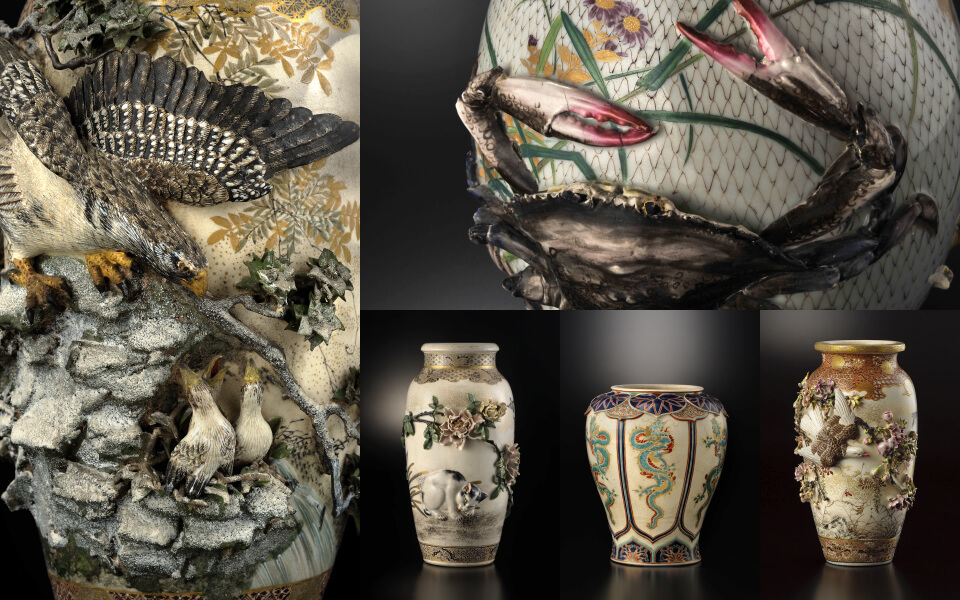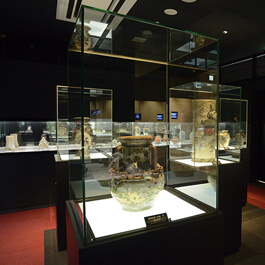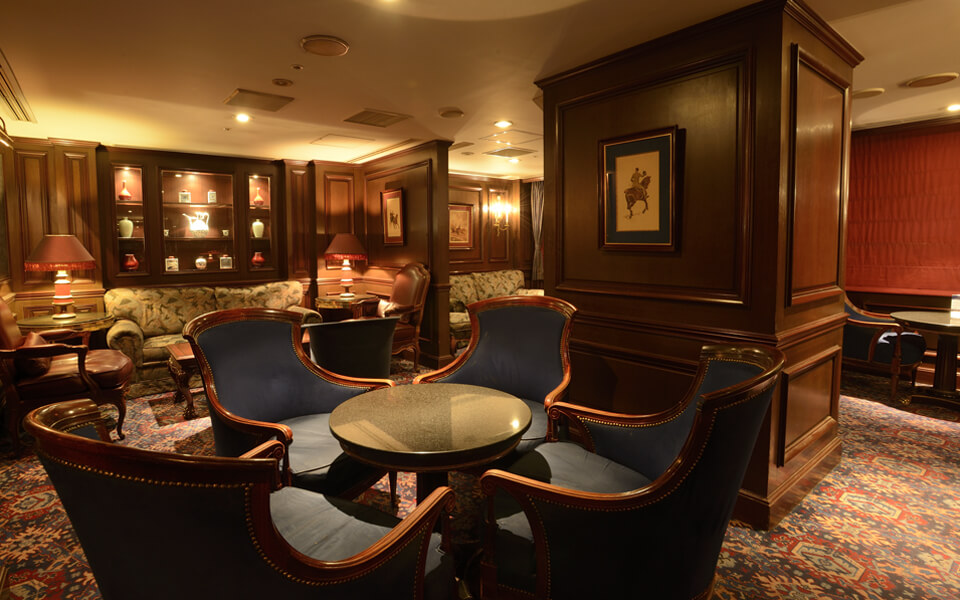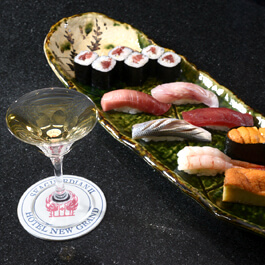A Taste of Luxury, in Yokohama

Even a century later, the magical craft of Makuzu ware continues to fascinate.
Makuzu ware (Japanese ceramics from Kyoto). The magical craft that appeared out of the blue in Yokohama during the Meiji era (1968-1912) and disappeared after the bombing of Yokohama at the end of the Pacific War. The craft is claimed to have been born when Kozan Miyagawa, born to a family of ceramists in Makuzugahara, Kyoto (around Maruyama Park today), started a ceramics business with the support of Tatewaki Komatsu, an important member of the Ishin Jikketsu (ten figures central to the Meiji Restoration) in Yokohama. From the sculpture of a cat grooming itself under ornamental flowers, to a hawk feeding its hungry hatchling, to a pigeon opening its wings wide while picking at the shoots of a cherry blossom flower, Makuzu ware explores 3D shapes with extensive detail and dynamism. The government, which, nine years after the Restoration was still steering domestic politics as if through thin ice, exhibited Makuzu ware at the 1876 Centennial Exposition in Pennsylvania, hoping that this would accelerate exports and improve the country’s lagging economy.
The Japanese exposition was managed by Judo Saigo. Coincidentally, he was a member of the Satsuma Domain (administrative division under the Tokugawa shogunate), just like Kiyokado Komatsu. Saigo had mostly probably heard about Kozan’s talent from the late Komatsu. Kozan lived up to those expectations. At the Centennial Exposition in Pennsylvania, he wowed the world with his unparalleled craftsmanship and extraordinary modeling skills. It’s hard to imagine that before Kozan, there was anyone who could make vases and censers with as much skill. A bird’s intricate feet wrapped around a branch and its thin, open beak must be baked at a different temperature from the vase itself due to the differences in complexity and thickness. If there is a slight error in temperature, no matter how small, it is impossible to achieve the exquisite details of Makuzu ware. The accuracy with which the kiln temperatures were controlled amazed the world. Japan’s aims at the Centennial Exposition were achieved. Exports of Japanese goods, primarily Makuzu ware, started rising. Then came the year after the exposition: the 10th year of Meiji (1877). The Satsuma Rebellion, considered the final act of the Shizoku rebellions (a war against the imperial government by discontented samurai) broke out, but, with the Japanese economy stabilizing with increased exports, the outcome of the battle was clear. After, Kozan Miyagawa’s Makuzu ware shop was handed down from generation to generation but closed down after suffering disastrous damage from the Pacific War. Today, some of the works can be appreciated at Miyagawa Kozan Makuzu Ware Museum. Located just 10 minutes from Yokohama Station, the museum will no doubt make you feel the same amazement that swept over the world 140 years ago.

Miyagawa Kozan Makuzu Ware Museum
6-1 Sakaecho, Kanagawa-ku, Yokohama
Tel: 045-534-6853
Sat – Sun 10am – 4pm
http://kozan-makuzu.com/

Your wish for luxury and leisure is granted, at Hotel New Grand’s Bar Sea Guardian II.
When you want to spoil yourself with luxury. When you’ve had enough of your daily routine, and need a breather. If you’re an adult, you probably have your own strategy for moments like these. Maybe it's going on a trip or splashing out on tailored clothing. Perhaps it’s buying a new car. But there’s a smarter, more reasonable way to make all your wishes come true: staying at a hotel. By spending some leisurely time in a relaxing space, you can put some energy back into your everyday life.
Staying at Yokohama’s Hotel New Grand is a perfect place for this. Once you’ve checked in, take a shower, get changed and wander to Bar Sea Guardian II with your room key. Those who enter the space will be enveloped in its dimly lit, lavish atmosphere and put at complete ease. Relaxing at the bar counter is a fantastic choice, so is settling down in one of the lofty, antique sofas, which are prime examples of Yokohama kagu (furniture). Yokohama kagu has a special history dating back over a century, when skilled craftsmen began repairing wooden furniture brought over from the West, eventually establishing a craft that continues to thrive today.
Once you’ve settled in, sift through the cocktail menu. Perhaps pay homage to the city and go for the “Yokohama,” or the Japan-born “Bamboo.” After all those drinks, you’ll be craving food, like sushi, which you can’t get at most bars, but Sea Guardian II has got you covered. It’s little luxuries like this that make going to hotel bars so pleasurable. Enjoy your time here for as long as your heart desires. This truly is luxury at its finest.

Hotel New Grand Bar Sea Guardian II
10 Yamashita-cho, Naka-ku, Yokohama
Tel: 045-681-1841
Mon – Sun 5pm – 11pm (L.O. 10:30pm)
https://www.hotel-newgrand.co.jp/english/
